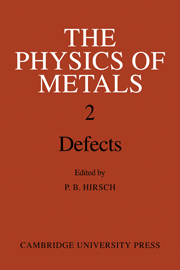Summary
INTRODUCTION
Since the original work due to G. I. Taylor (1934) numerous attempts have been made to explain the work hardening phenomena in terms of dislocation mechanisms. Much progress has been made on the experimental side in determining the nature of the stress–strain curves of various materials as a function of various parameters such as temperature, strain rate, grain size, crystal orientation (in the case of single crystals), alloy composition etc. The development of methods for the direct observation of dislocations, mainly by transmission electron microscopy and etch-pitting techniques, has made it possible to study in detail the internal distribution of dislocations as a function of deformation, and the dislocation arrangement is now quite well established in a number of cases. Studies of slip lines have also yielded valuable information on the scale on which the slip processes take place. Dislocation theory has seen much development and a number of mechanisms and dislocation interactions important in work hardening have been established. However, in spite of a spate of theories during the last few years designed to explain the work hardening of single crystals, the phenomena are still not well understood. The aim of any work hardening theory is to explain the stress–strain curve, and its dependence on temperature, strain-rate, etc. This involves usually the assumption of a model of the dislocated state, which is characterised by a flow stress which depends on one or more parameters of the dislocation distribution, and the variation of these parameters with strain.
- Type
- Chapter
- Information
- The Physics of Metals , pp. 189 - 246Publisher: Cambridge University PressPrint publication year: 1976
- 3
- Cited by



